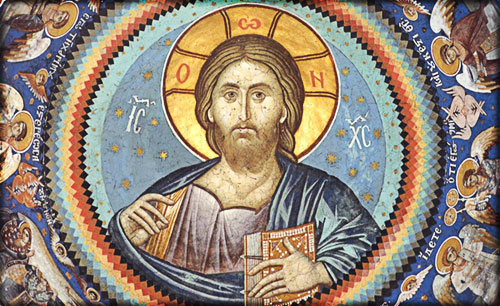
ICONOGRAPHY IS THE ORIGINAL TRADITION of Christian sacred art, and has been an integral part of the worship and mystical life of Christians since apostolic times. Referred to in the Eastern Christian tradition as "windows into heaven," they have inspired and uplifted millions of the faithful, and have at times been the instruments for demonstrating God's miraculous intercession in the life of mankind.
The History of
Icons
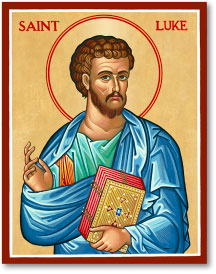 Church tradition teaches that the first iconographer was Saint Luke the Evangelist. He painted the holy image of the Virgin Mary on a panel, a face which he himself had seen. He brought his first icons to the Mother of God herself, who approved them and proclaimed: "May the grace of Him Who was born of me, through me, be imparted to these icons." There are at least five highly-venerated icons of the Virgin painted by Saint Luke which are still venerated today. He is also known to have painted icons of Saints Peter and Paul. The beginnings of iconography can also be found in the catacomb paintings of the second and third centuries.
Church tradition teaches that the first iconographer was Saint Luke the Evangelist. He painted the holy image of the Virgin Mary on a panel, a face which he himself had seen. He brought his first icons to the Mother of God herself, who approved them and proclaimed: "May the grace of Him Who was born of me, through me, be imparted to these icons." There are at least five highly-venerated icons of the Virgin painted by Saint Luke which are still venerated today. He is also known to have painted icons of Saints Peter and Paul. The beginnings of iconography can also be found in the catacomb paintings of the second and third centuries.
Iconography was given special attention and favor by the early Byzantine Empire. The emperor Constantine the Great relieved of all taxation the artists who made the mosaics for the churches. Iconography flourished through the Empire, as mosaics, wall paintings (frescoes), and panel (portable) icons. It became most fully developed and widely spread in the Empire in the sixth century, under the rule of Justianian the Great.
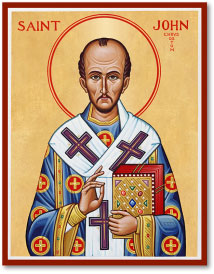 It was the custom of Saint John Chrysostom to keep an icon of Saint Paul before him whenever he studied the Epistles of Saint Paul, for inspiration and to invoke the Apostle's blessing. As another Church Father, Saint Basil the Great, said, "With a soundless voice the icons teach those who behold them." Once when Saint John looked up from the text, the icon of Saint Paul seemed to come alive and the Apostle spoke to him.
It was the custom of Saint John Chrysostom to keep an icon of Saint Paul before him whenever he studied the Epistles of Saint Paul, for inspiration and to invoke the Apostle's blessing. As another Church Father, Saint Basil the Great, said, "With a soundless voice the icons teach those who behold them." Once when Saint John looked up from the text, the icon of Saint Paul seemed to come alive and the Apostle spoke to him.
Iconography, as an integral part of Christian life, was subject
to great controversy in the seventh and eighth centuries. The Iconoclasts
("icon-smashers") were suspicious of any sacred art which represented human
beings or God, and demanded the destruction of icons. The Iconodules (venerators
of icons) vigorously defended the place of icons in the life of the Church.
Iconoclasm may have been influenced by Jewish and Moslem ideas, and also reflected
a "puritan" outlook in Christianity which saw in all images a latent idolatry.
The Iconodule position was upheld by the Seventh and last Ecumenical Council, which met in Nicaea in 787 A.D. Another attack on icons by the Emperor Leo III during the next century was overturned when the Empress Theodora permanently reinstated the veneration of icons in 843, a victory which is commemorated as "the Triumph of Orthodoxy."
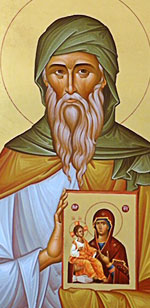 One of the chief champions of icons during this period was Saint John of Damascus, who wrote in his famous "Defense of Icons": "Through the icons of Christ we contemplate His bodily form, His miracles, and His sufferings, and we are sanctified...The icons of the Saints are filled with the Holy Spirit."
One of the chief champions of icons during this period was Saint John of Damascus, who wrote in his famous "Defense of Icons": "Through the icons of Christ we contemplate His bodily form, His miracles, and His sufferings, and we are sanctified...The icons of the Saints are filled with the Holy Spirit."
After the fall of Constantinople, the Holy Mountain of Athos became a great center of iconography. The many monastic churches that can be seen at Mount Athos today are testimony of a centuries-long tradition that flowered at the hands of the monks who preserved it. The Byzantine tradition of iconography also was emulated by the Serbian and Russian Christians, whose styles of iconography have undergone their own evolution over the centuries.
Although many of us associate iconography with the Church of the East, it is also the original tradition of sacred art in the Western Church. Mosaics, frescoes, and paintings in Rome, Spain, and France bear witness that the Byzantine style was the artistic tradition common to both Western and Eastern Christianity up to the twelfth century.
The Purpose of Icons
In describing the purpose of icons, the early Fathers used the Greek work anagogic, literally meaning "leading one upward." Photios Kontoglou, the renowned modern iconographer, expressed this perfectly: "Icons raise the soul and mind of the believer who sees the icon to the realm of the spirit, of the incorruptible, of the kingdom of God, as far as this can be achieved with material means." So to appreciate iconography fully, we must approach it as a liturgical art form whose function is essentially spiritual.
Since the creation of an icon is itself a sacred activity, the iconographer must be a person of prayer, not merely a technician. If his work is to inspire and illumine others, then it is essential that he leads a life of prayer and fasting that he may be inspired and illumined by the Holy Spirit, that his iconography becomes itself an expression of his spiritual life. Kontoglou writes: "The iconographers painted as they prayed."
In the Western approach to sacred art (such as those from
the Renaissance) the artist most frequently depicts his subject in a purely
naturalistic and representational style. He uses the same techniques as he
would to depict a secular subject. The theme may be religious, but the style
remains the same.
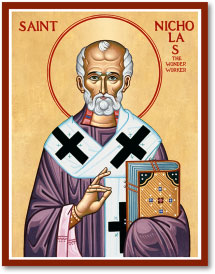 As the goal of the iconographer is utterly different, so
are his techniques to accomplish this goal. Iconography depicts the saints
not as they were in actual life, but as they are in eternity. He communicates
his vision of the heavenly world not through symbols, such as sunsets with
golden clouds or angels playing harps, but through mystical forms and colors.
As Kontoglou writes, "Iconography expresses with spiritualized forms abstracted
from natural phenomena, a world which is beyond phenomena, a spiritual world."
Described
as "theology in line and color," iconography traditionally uses particular artistic
devices and stylization to communicate the spiritual world to the beholder.
One of the first things one notices is the standardization of the forms of holy
persons. Upon seeing an icon we can immediately recognize that this is Christ,
this is Saint Paul,
this is Saint Nicholas,
etc. Both the forms of the Saints and the composition of events from the Gospels
are fixed and archetypal, although they will vary slightly depending on the
iconographer.
As the goal of the iconographer is utterly different, so
are his techniques to accomplish this goal. Iconography depicts the saints
not as they were in actual life, but as they are in eternity. He communicates
his vision of the heavenly world not through symbols, such as sunsets with
golden clouds or angels playing harps, but through mystical forms and colors.
As Kontoglou writes, "Iconography expresses with spiritualized forms abstracted
from natural phenomena, a world which is beyond phenomena, a spiritual world."
Described
as "theology in line and color," iconography traditionally uses particular artistic
devices and stylization to communicate the spiritual world to the beholder.
One of the first things one notices is the standardization of the forms of holy
persons. Upon seeing an icon we can immediately recognize that this is Christ,
this is Saint Paul,
this is Saint Nicholas,
etc. Both the forms of the Saints and the composition of events from the Gospels
are fixed and archetypal, although they will vary slightly depending on the
iconographer.
Another outstanding feature of iconography is the extreme stylization and non-naturalistic depiction of the clothing of the figures. The folds of the clothes are depicted by means of geometric forms (ovals, rectangles, triangles), demonstrating a heavenly order. Again, the selection of colors is also often fixed: blue for Christ's mantle or outer garment, red for the tunic or inner garment; deep wine-red for the Virgin Mary's outer garment; etc.
This stylization also appears in all the elements of the
faces and body members of the persons in the icon.Their faces do not resemble
mere human beings, but through stylization they show us the faces of human
nature transformed into the divine. The hands are often thin and expressive,
commonly in various gestures of blessing. The halos around the heads of Christ,
the Virgin Mary, and
the Saints are painted
as a clearly delineated circle, signifying their sanctity and drawing our
attention to their faces.
Even nature itself is transformed by the hand of the iconographer.
Buildings, mountains, trees and animals are usually depicted in a very simplified,
schematic way, rather than attempting to render a photographic likeness.
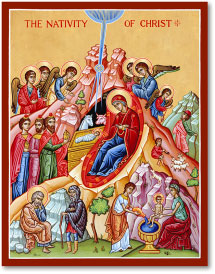 The iconographer does not stop there in his use of technique to depict a spiritually-transformed reality. He alters both time and space. Events that took place at different times are represented simultaneously in the composition as if they took place simultaneously--such as is seen in Monastery Icons' depiction of the Nativity of Christ, for example, where we see simultaneously in one icon the Virgin with the swaddled Infant, the midwives bathing the Child Jesus, the angel announcing the Savior's birth to the shepherds, and the Magi coming to adore the Messiah. Nor does the iconographer adhere to a systematic use of perspective to create the illusion of three-dimensionality. Instead he frequently uses an inverted perspective to show, where objects in the foreground are smaller than spiritually more significant objects or persons behind them.
The iconographer does not stop there in his use of technique to depict a spiritually-transformed reality. He alters both time and space. Events that took place at different times are represented simultaneously in the composition as if they took place simultaneously--such as is seen in Monastery Icons' depiction of the Nativity of Christ, for example, where we see simultaneously in one icon the Virgin with the swaddled Infant, the midwives bathing the Child Jesus, the angel announcing the Savior's birth to the shepherds, and the Magi coming to adore the Messiah. Nor does the iconographer adhere to a systematic use of perspective to create the illusion of three-dimensionality. Instead he frequently uses an inverted perspective to show, where objects in the foreground are smaller than spiritually more significant objects or persons behind them.
Icons of the Saints & Iconographic Symbolism
"Even if he has seen a certain saint in life, the iconographer does not paint him materialistically or naturally, but in a spiritual manner, illumined by divine grace," wrote the reknowned modern iconographer Photios Kontoglou.
The iconographer uses several traditional means to depict the sanctified humanity of the Saints. Their faces and body members are stylized, their hands are expressively held in various gestures of blessing. Even the geometric folds of their clothes speak of a heavenly order and balance. The halos around their heads are drawn in a clearly delineated circle, signifying their sanctity and drawing our attention to their faces.
Frequently a saint's icon features some important reference to their life or words: Saint Christopher grasps his staff that miraculously blossomed as a palm tree, just as the Child Jesus foretold it would the day after His apparition to the saint. Saint Therese of Lisieux said that after her death she would "let fall a shower of roses," referring to the graces and heavenly gifts she would bestow, and these are represented in her icon by a cluster of pink roses. Martyrs such as Saint Cecilia and Saint Barbara hold a cross, signifying their following Christ unto death as we also find in icons of monks and nuns such as Saint Benedict and Saint Rose of Lima, who underwent the "green martyrdom" of the monastic life.
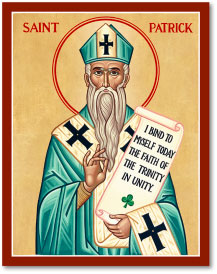 In many icons the saints hold a scroll that quotes their own words (such as Saint Patrick, whose scroll quotes his words on the Trinity from his famous Lorica) or a scriptural quote which highlights some outstanding feature of their life and struggle, as in Monastery Icon's depiction of Saint Monica, whose successful labor of prayer for the conversion of her son Saint Augustine is summarized in the quote from the Psalms: "In my distress I called unto the Lord, and He heard me." Other saints, like Saint Francis de Sales and Saint John Baptist de La Salle, hold copies of their own spiritual writings.
In many icons the saints hold a scroll that quotes their own words (such as Saint Patrick, whose scroll quotes his words on the Trinity from his famous Lorica) or a scriptural quote which highlights some outstanding feature of their life and struggle, as in Monastery Icon's depiction of Saint Monica, whose successful labor of prayer for the conversion of her son Saint Augustine is summarized in the quote from the Psalms: "In my distress I called unto the Lord, and He heard me." Other saints, like Saint Francis de Sales and Saint John Baptist de La Salle, hold copies of their own spiritual writings.
How does the iconographer know how to depict a particular saint? The appearances of hundreds of saints are described in various iconographers' manuals. Figures like Saint Nicholas and Saint Basil have been depicted in hundreds of icons through the centuries; a Christian from Greece or Russia would immediately recognize Monastery Icons depictions of these and other saints, even though they may not be able to read the English text identifying them.
Some icons are created with the help of contemporary descriptions or paintings done during or shortly after the saint's own lifetime such as our icons of Saint Francis and Saint Thomas More. And with the help of photography, there are now actual photographs of the saints that the iconographer can refer to, as our iconographer did when he painted the icons of Saint Therese of Lisieux and Saint Pius X.
Saint Basil the Great wrote: "What the Book of the Gospels explains by means of words, the iconographer shows by means of his works." To learn about how an icon is created, visit another page at this site, How Are Icons Painted?.